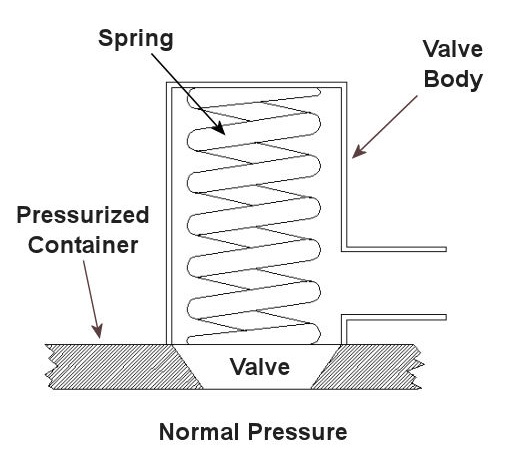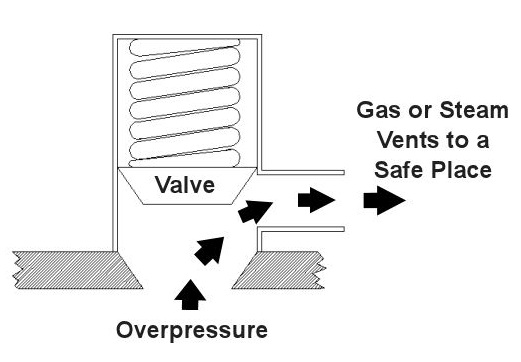| Over the last few weeks we looked at the dangers associated with pressurized containers, also known as “pressure vessels.” We also looked at overpressure devices that can keep the pressure from building to the point where the vessel ruptures. But what about keeping pressure vessels from rupturing under normal operating pressure? You know, pressures well below the point where an overpressure device would kick in. This can happen if there is some sort of weakness in the pressure vessel caused by things like poor design, defective materials, or bad welds.
In the 19th Century the machines of the Industrial Revolution were driven by steam. Those magnificent machines advanced our civilization and standard of living. Sounds like a win-win situation, right? Wrong! The downside was that there were no standards for the design of pressure vessels like air storage tanks and boilers. Every engineer had their own ideas as to how they wanted to approach pressure vessel design. I use the word “engineer” loosely because most “engineers” of that time were not college graduates. Some approaches were good, some were bad, and some were in between. The end result was often not good. There were many pressure vessel leaks and explosions that damaged property, caused injury, and took lives. By the turn of the 20th Century industrialization spread far and wide, intensifying safety concerns about pressure vessels. One deadly incident was the straw that broke the camel’s back. On March 10, 1905, the boiler failed in a shoe factory in Brockton, Massachusetts. 58 people were killed and another 117 were injured. The factory was completely destroyed. This tragedy prompted Massachusetts to form a Board of Boiler Rules to write boiler laws. Ohio followed with their own boiler laws. This was a step in the right direction, but each state law was different and a boiler that was legal in one state was illegal in another. There was no standardization between states. In 1911 the American Society of Mechanical Engineers (ASME) formed its Boiler and Pressure Vessel Committee to address the lack of standardization. The committee’s work resulted in publication of the Boiler and Pressure Vessel Code (BPVC). In a nutshell, the BPVC establishes standardized rules governing the design, fabrication, testing, inspection, and repair of boilers and other pressurized vessels and containers. The BPVC set the standards that can be adopted by all states to minimize risk to the public. The ASME is not a government agency, so it cannot enforce compliance with the BPVC. As a matter of fact, compliance with the BPVC by manufacturers has been completely voluntary. However, most state laws now require that pressure vessels must be certified by their manufacturers to be in compliance with the BPVC before they can be sold and put into operation. A certified pressure vessel must be permanently and conspicuously marked with the manufacturer’s name, the date built, serial number, and information about its construction and the type of use it’s designed for. That wraps it up for our series about pressurized containers. Next time, we’ll shift gears and take a look at the project triangle and how it influences the outcome of engineering designs. _____________________________________________ |
Posts Tagged ‘boiler explosion’
Pressurized Containers – ASME Boiler and Pressure Vessel Code
Sunday, October 24th, 2010Pressurized Containers – Industrial Overpressure Devices
Sunday, October 17th, 2010| Perhaps you went out on a drive to enjoy a nice summer day. As you ventured into uncharted territory, you might have ended up in an industrial area. There, you noticed factories, chemical plants, and oil refinery complexes, each surrounded by a huge system of pipes and tanks. You might have considered it to be an eyesore, but if you’re an artist and engineer like I am, you might look at it as a form of art, composed of interesting shapes, colors, and patterns. No matter how you look at it, you can bet that there are at least a few pressurized containers in there.
Last time we saw how something as seemingly harmless as a home water heater could become a dangerous missile if the pressure inside builds to the point where the tank ruptures. You can imagine what kind of explosive forces, steam, and chemicals would be unleashed into the surroundings if an industrial sized pressurized container failed due to overpressure. Let’s explore some other types of overpressure devices that are commonly used in industrial settings. One type of overpressure device is a safety valve. They are similar to a water heater relief valve, but they are generally used to relieve overpressure of gases and steam. How do they work? Basically, a safety valve is attached to the top of a pressurized container as shown in the cut away view in Figure 1 below. Figure 1 – A Basic Safety Valve In The Closed Position A powerful spring in the valve body is designed to force down on the valve and keep it closed if there is normal pressure inside the container. Once the pressure begins to rise to an unsafe level, it pushes up against the valve and overcomes the force of the spring. The valve opens, as shown in Figure 2 below, and the contents of the pressurized container are safely vented out to an area that is normally unoccupied by people. In case you’re wondering, safety valves are commonly used on pressurized storage tanks and boilers. Figure 2 – A Basic Safety Valve In The Open Position Another way to address the overpressure scenario is to employ a rupture disc. This is in fact a purposely constructed weak spot. It is intentionally built into a pressurized container and is designed so that it will fail when pressure starts to rise. In fact, this disc is designed to fail at a pressure point just below the pressure at which the container itself would fail. The disc is usually located within a vent pipe, which is in turn connected to the container. Should the disc rupture in an overpressure situation, the contents of the pressurized container will safely flow out of the vent pipe to a place normally unoccupied by people. The advantage of using a rupture disc is that they are made to safely release huge quantities of pressurized substances very quickly. The disadvantage in their usage is that they’re a one-time fix. That is, unlike relief or safety valves which may perform their function a multitude of times, a rupture disc is destroyed once it does its job. They are generally used in industrial settings where potential hazards are greater than at home, so once the rupture disc blows, the complete system generally undergoes a shut down so that the disc an be replaced before the pressurized container can be used again. Another option to pressure containment is the use of a fusible plug, usually constructed of a metal that will melt if the temperature within a pressurized container rises above a certain level. The metal plug melts, and excess pressure is vented through the aperture formed into a safe location. These are often used on locomotive boilers and compressed gas cylinders. Like rupture discs, fusible plugs are a one-time fix and must be replaced once they have done their job. Yet another option to pressure containment is to use a temperature limiting control. This category includes devices that monitor temperature and pressure within a pressurized container. If a dangerous situation should develop, the control system reacts, effectively reducing the pressure to prevent failure of the vessel. Automatic combustion control systems for boilers in electric utility power plants use temperature and pressure sensors to keep pressures within safe limits by regulating fuel and air input to the boiler. Next time we’ll cover the American Society of Mechanical Engineers (ASME) Boiler and Pressure Vessel Code (BPVC), which establishes rules governing the design, fabrication, testing, inspection, and repair of boilers and other pressurized containers. _____________________________________________ |
Coal Fired Boiler Explosions
Sunday, July 25th, 2010|
Try this for a tongue-twister: Coal fired electric utility power plant boiler… If you’ve been reading along with us for the last couple of weeks, you now have a pretty good idea of what these are and what they do. These boilers are contained within furnaces in coal fired power plants. The furnace’s job is to combine coal and air to create a combustion process. It is like a big, insulated enclosure that keeps the heat energy from the combustion process from escaping before it can be absorbed by the water and steam in the boiler tubes. The heat energy is then funneled to the steam turbine to spin an electrical generator, creating the energy which will eventually find its way into our homes and businesses. During the operation of the boiler, coal and air must be introduced into the furnace at carefully measured rates to maintain a proper fuel-to-air ratio which will enable the release of heat energy from the coal at a safe, controlled rate. Fuel-air ratio is the amount of coal entering the furnace divided by the amount of air entering the furnace. If this ratio isn’t precisely maintained, conditions may be right for an explosion to occur. Specifically, the ratio has to fall within an “explosive range.” Once within this range, all that is needed is an ignition source, such as hot ash, or even mere static electricity, and the result may be a furnace explosion. There are certain times at which furnace explosions are more likely to occur than others, such as when the boiler is being started, operated at less than full capacity, or shut down. When a furnace explodes, a pressure wave moves out from the center of the blast. This pressure wave will bear up against the sides of the furnace with great force, and if the pressure is high enough the sides of the furnace, which are made of heavy steel components, will actually bend and split open. Boiler tubes may even rupture, releasing high pressure steam and water into the power plant and furnace. At the very least, the boiler will be down for expensive repairs and no electricity can be produced by its turbine generator. This down time can last for many months and results in lost revenue to the energy producer. Aside from an explosive fuel-to-air ratio, there are other potential causes of furnace explosions. For example, poor coal quality can lead to incomplete combustion, or the flame going out completely, encouraging unburned coal particles to settle and accumulate in the furnace. The accumulation of coal can grow to the point where it forms an explosive mixture when combined with the right amount of air. So how can boiler explosions be prevented? The National Fire Protection Association (NFPA) looked into the problem and developed an industry standard. This standard is known as NFPA 85, Boiler and Combustion Systems Hazards Code. Its purpose is to contribute to operating safety and prevent uncontrolled fires, explosions, and implosions of coal fired boilers. NFPA 85 lays out guidelines to follow when designing, building, and operating boiler fuel handling systems, air handling systems, and combustion control systems. Following its guidelines will certainly significantly decrease the probability of explosions occurring. Another means of explosion prevention includes implementing a boiler operator training program. These enable attendees to better understand operating procedures and equip them with the knowledge to safely control the combustion process, particularly when a furnace explosion is most likely to occur. This training can be done with a combination of classroom instruction along with time on a simulator and may be followed up with hands-on training in the plant itself. Lastly, boiler explosions can be prevented by implementing an effective inspection and maintenance program to locate and repair or replace boiler components, averting the possibility of a potential disaster occurring. Things such as check lists can be used to ensure that nothing is missed. This is a strategy that all pilots must use before starting their planes, and it is now being used in hospitals as well to cut back on the rate of patient infection due to carelessness on the part of hospital staff. Hey, we’re all human, and humans are not perfect. But remember that an ounce of prevention is truly worth a pound of cure, and then some. A properly placed check on the list could mean lives will be saved. _____________________________________________ |







